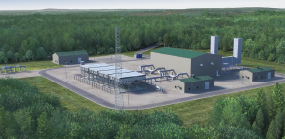Introduction
The Gulf of Mexico offshore area is one of the most important natural gas supply areas in the United States. This report was prepared by Foster Associates, Inc., on behalf of the INGAA Foundation, to promote greater understanding of the role this dynamic producing area plays in the U.S. energy profile. The report discusses important offshore producing regions, producers and relevant new development areas, as well as the infrastructure of gas pipelines necessary to transport these supplies to U.S. markets. Pipeline characteristics covered include identification of pipelines and their ownership, location and facility configurations, diameter and new pipeline proposals.
Offshore Gas Supply Regions
The Gulf of Mexico offshore natural gas producing area provides U.S. markets with 26 percent of indigenous gas supplies and contains 18 percent of proven reserves. In addition, potential recoverable reserves total 48 Tcf, representing 21 percent of the total Lower 48 States’ potential gas reserves.
The Gulf can be divided into different producing regions, such as federal and state waters. The federal waters contain the majority of the offshore producing reserves (95 percent), with the remaining reserves split between Louisiana state waters (3 percent) and Texas state waters (2 percent). For the purpose of this analysis, Foster Associates has further divided the Gulf of Mexico federal waters into five regions: Eastern Louisiana, Central Louisiana, Western Louisiana, Texas and the Eastern Gulf.
In terms of production, discovered reserves, and leased acreage, the Central and Western Louisiana regions are the largest of the Gulfs regions. The following table presents gas supply data for each of the five regions.
Table 1
Since the mid-1950s, the Minerals Management Service of the U.S. Department of the Interior has leased 26 million acres, representing 4,966 leases in the Gulf. About 61 percent of these leases are not currently producing, providing abundant potential for further development opportunities. The regions with the highest proportion of nonproducing acreage are the Eastern Gulf, Texas and Eastern Louisiana.
Three major interest areas in the Gulf of Mexico are deepwater drilling, Eastern Gulf reserves and subsalt drilling. One of the first deepwater projects commenced production in 1994 when Shell installed its tension leg platform in the Auger project (Garden Banks Block 426) at a water depth of 953 meters. Several other deepwater projects are currently underway in the Mississippi Canyon, Viosca Knoll and Green Canyon areas. Eastern Gulf discoveries have been particularly significant in the mobile Bay area. One promising area is the Norphlet trend, with 7 to 8 Tcf of potentially recoverable reserves. Finally, the subsalt trend offers substantial promise in light of recent drilling successes, particularly the Mahogany project in the Ship Shoal area being developed by Phillips, Anadarko and Amoco.
While the Gulf of Mexico production and lease holdings are not overly concentrated within a few large companies, market shares for the 10 largest producers in the Gulf do exceed the U.S. average. The 10 largest lease owners hold approximately 53 percent of the federal acreage and the 10 largest companies produce 52 percent of the total offshore production. For the total U.S. (onshore and offshore), the market share for the 10 largest gas producers is about 31 percent.
Offshore Pipelines
About 130 companies operate pipelines in Gulf of Mexico state and federal waters. Active offshore gas pipelines total 14,773 miles, with approximately 91 percent located in federal waters and 9 percent in state waters. Over 20 percent of the active pipeline mileage has been constructed within the past five years. Gas producers (majors and independents) have constructed three-quarters of these lines. An additional 775 miles of pipe are currently planned for the Gulf of Mexico, and producers are also responsible for the majority of this proposed mileage.
Owners of existing offshore pipelines are primarily a mix of interstate transmission companies and gas producers. The 10 largest companies own 53 percent of the total offshore mileage. Eight are interstate pipelines and two are producers. Of the next 10 large owners, four are interstate pipelines and six are producers. The concentration of pipeline ownership (e.g., the top 10 companies hold 53 percent) is consistent with the concentration of production, where the top 10 lease owners hold 53 percent of the federal offshore leases and the 10 largest producers represent 52 percent of the production.
The distribution of offshore pipeline mileage by ownership type, region and size is shown on the following table.
Table 2
Interstate pipelines own about half of the offshore mileage, primarily in Central and Western Louisiana. Across the entire Gulf of Mexico, producers (majors and independents) own 46 percent of the total offshore pipeline mileage, with concentration of their ownership in Eastern Louisiana and in Texas. Producers own the majority of the pipelines in the newer Eastern Gulf areas.
Offshore pipeline size (diameter) ranges from very small lines (e.g., 2 inches) to large diameter pipelines. The mileage distribution by size is as follows:
Table 3
The larger diameter pipeline (over 18 inches) makes up 27 percent of the mileage, with about 9 percent greater than 27 inches in diameter. State waters have a higher proportion of large diameter pipelines, primarily because the larger diameter lines from federal waters traverse state waters to reach onshore points. Interstate pipelines own about 85 percent of the large diameter pipelines; however, this proportion will fall when proposed lines are constructed and become operational.
Regional Summary
The following table summarizes the relative importance of each region, the largest lease holders and pipelines, pipeline ownership and location of new pipelines.
Table 4
The regions with the highest proportion of producing leases also have the highest proportion of pipeline mileage. Only in the Central and Western Louisiana regions do interstate pipelines own the majority of the mileage. The 10 largest companies own the highest proportions of the pipeline mileage in offshore Texas and the Eastern Gulf, yet these are the areas where the interstate pipelines’ percentages are the lowest.



